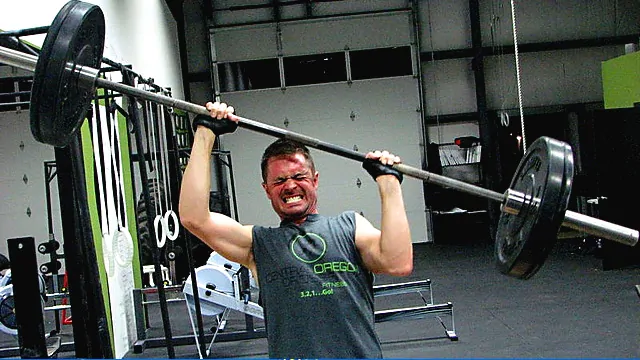
Hello! Can you believe we made it through the holidays, and it's already January? Along with other things, that means there's a whole lot of us who are hitting the gym, either for the first time ever or for the first time in a while.
This is a great thing. Movement and exercise are actually necessities for our bodies to function properly. Keeping a regular, consistent movement-and-exercise routine can really help keep our bodies function better. So I'm always glad when I hear about people getting serious about staying MOBILE.
However, this is also a time when our practice sees a lot of injuries from people doing a little too much, too fast, as they start to live out their New Year's resolutions.
The vast majority of these injuries can be boiled down to two things:
For this first tip, we need to go over a concept called the core cylinder. The basic purpose of our core muscles is to attach our rib cage to our pelvis. This helps to stabilize our spine and protect it when lifting heavy loads.

If you don't stack your rib cage over your pelvis, your low back pays the price. The picture above shows the most common postural fault that I see daily in my practice. This position is called the open scissors position. This position disconnects your rib cage in your pelvis and leaves your low back to do the majority of the work when lifting weights.

So the first step is to learn how to stack your rib cage over your pelvis with an active core. The picture above shows the proper alignment between your pelvis and your rib cage when lifting weights. So before you start any lift, make sure to drop your rib cage into your pelvis so that the two are stacked on top of each other. This will greatly reduce the strain on your low back and reduce injuries when lifting.
The number one lifting injury that I see in my clinic is to the low back. However, the number two injury is shoulder injuries. Many shoulder injuries that result from lifting originate with bad form in upper body exercises.
This can be fixed by putting your shoulder blade in the strongest position possible before starting any upper body lifts. The video above demonstrates the most common non-ideal shoulder positions that many of us commonly utilize.
After showing what poor positioning of the shoulder blade looks like, the video above shows how to properly position your shoulder blades as you prepare for upper body lifts. This position lets the maximum number of muscles contribute to upper body lifts in order to not overload any one muscle in the shoulder.
If you follow these recommendations, you will notice much less shoulder pain when doing upper body exercises
The third most common injury I see with people starting exercise routines is neck and upper back pain. Many of the muscles of the upper body have some connection to the neck and upper back. If the neck is not in an ideal position, lots of injuries can occur when doing upper body exercises.

The picture above shows the common issue many people have with their neck position when doing upper body lifts and exercises. This position really puts the neck and upper back in a vulnerable position and can easily lead to injury. Notice the difference in the position below as the model STACKS his bones correctly.

The picture above shows the proper way to position your neck and upper back before you start any upper body lifts. Position your neck and upper back as you see above and you'll notice much less neck, shoulder, and upper back pain when doing upper body exercises.
So there you have it. Follow these three steps and you will have much fewer issues with injuries when lifting weights in the gym. If you read this blog too late - and you are already dealing with an injury from the gym - give us a call at Movement Laboratory - 918-300-4084 - and let us help you get out of pain and back to seeking those gains in this new year!


So you're killing it in the gym! Maybe you found a great CrossFit gym, or you are weightlifiting on your own. You are consistently hitting 2-5 workout days each week. You make sure to have rest days to allow your muscles to recover. Now you're ready to start increasing your weights. But, how? Increase reps, increase sets, go heavier?! There are so many options.
I recommend letting your goals show you the way. Your goals can dictate the path that's best for you:
Most training programs involve performing the bulk of your exercises in that 8–12 rep sweet spot for a few reasons.
When trying to find your starting weight, follow this program.
Using this method, you will be able to find your ideal starting weight! This will allow you to “build a base,” perfect your form, and gain confidence for weight increases to come.
Be aware of newbie gains! When you first start strength training, you’ll likely notice a more dramatic increase in strength than you will at any other point in your strength-training journey. That’s largely because during the first couple of weeks of any strength program, the bulk of your strength gains don’t come from putting on actual muscle. Those early strength gains are due to a combination of neurological changes—basically, your brain and muscles learning to work efficiently together so that the muscle cells fire and contract with more force.
What’s more, each person has a different upper limit to how much strength their bodies can gain.
So no matter what your training experience is, knowing when you’re ready to increase weight is as simple as counting reps and watching form. If you are finishing your sets and feel like you could have done 3-4 more reps with no problem, it's probably time to start thinking about an increase.
If you are ready to increase, then your goals will again tell you how.
One important note: If you feel like you are ready to make weight increases with deadlifts and squats before you’re ready to make weight increases with triceps extensions or biceps curls, don’t worry. That’s natural. Many people tend to be stronger on lower-body exercises, at least initially. You will likely see faster weight increases with compound, multi-joint lifts such as squats, bench presses, rows, and deadlifts than with single-joint isolation ones such as leg extensions, triceps extensions, and hamstring curls.
It’s best to look at weight increases in terms of a percentage of the weight you’ve been lifting. For example, going from 5 to 10 pounds with shoulder raises might be the same jump in poundage as going from 100 to 105 pounds with deadlifts, but one requires doubling the weight while the other accounts for a 5 percent increase in weight. Generally, you should limit week-to-week weight increases for any given lift to no more than 10 percent.
Sometimes the weights available to you might mean you have to make a larger increase if you want to increase at all. In that case, always listen to your body, pay attention to your form, and cut your reps accordingly so that you can get through them all without breaking form.
In fact, it’s totally normal to start using a heavier weight and then not be able to quite hit the top of your rep scheme at first. In a few weeks, you will be able to, and then you can up your weights again. For example, if you were doing 3 sets of 12 reps of overhead presses, you may only be able to handle 3 sets of 10 reps when you bump up the weight. If you’re still in that 8–12 rep range, that’s totally fine, and in time you’ll be back to feeling like 12 reps is easy and you'll be ready to once again increase the intensity.
Lifting more weight can be awesome, but lifting too much increased weight comes with some unwelcome side effects. The big one is delayed-onset muscle soreness, or DOMS. Each time you increase the amount of stress you put on a muscle, more microscopic damage occurs within the muscle cells, leading to an uptick in pain during the 24 to 72 hours following your workout as the muscle repairs itself. However, just because DOMS hurts - that doesn’t mean it’s necessarily bad. It’s a normal part of your body recovering from the stress of lifting.
Also, beware of the dangers of our human ego. It can be tempting to get so caught up in moving more weight that you start to break down in your form. Never sacrifice form to lift more weight. This is the quickest path to injury.
So there you have it. Follow these rules to safely increase those gains: